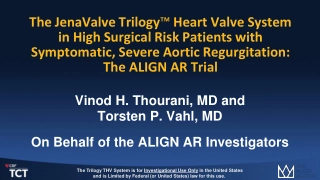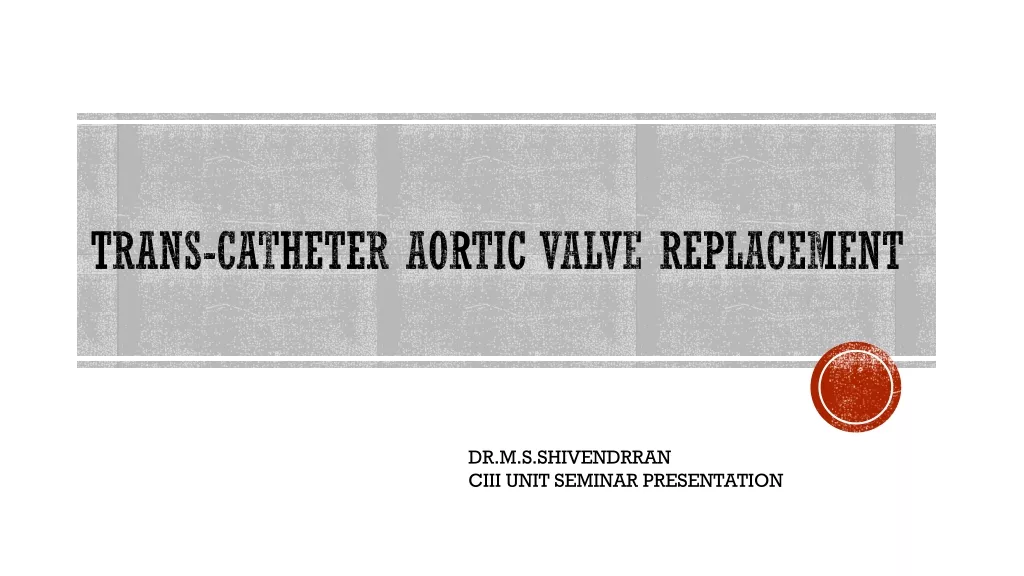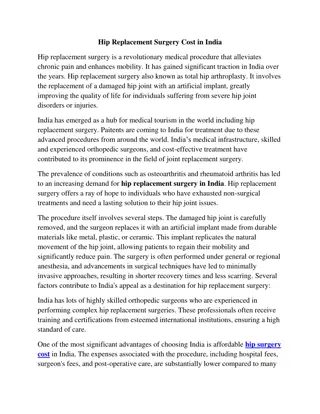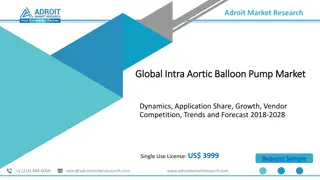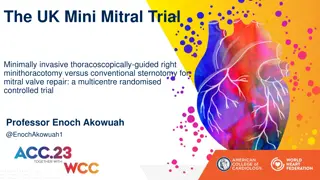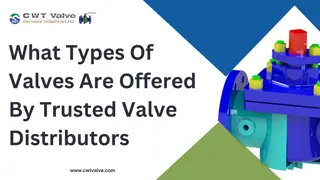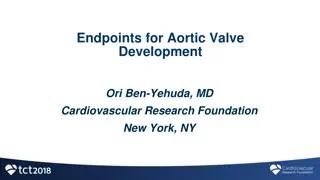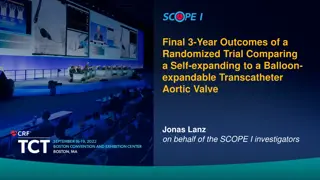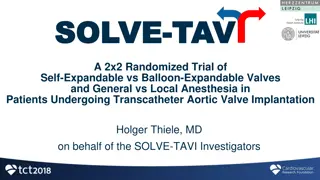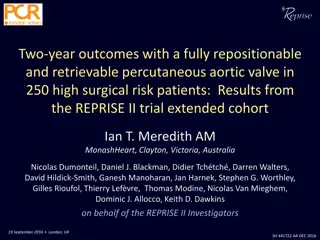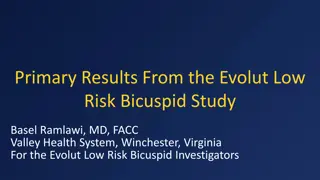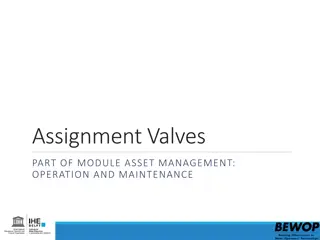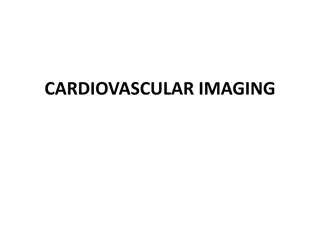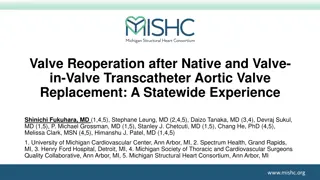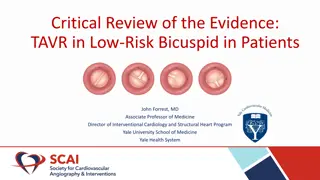Comparison of Self-Expanding Bioprostheses in Transcatheter Aortic Valve Replacement
The SCOPE II randomized clinical trial compared the early and mid-term performance of the ACURATE neo and CoreValve Evolut self-expanding bioprostheses for transcatheter aortic valve replacement in patients with severe aortic stenosis. The study devices differed in features such as expansion, recapturability, annular fixation, and valve sizes. The trial aimed to evaluate the efficacy and outcomes of these devices in treating aortic valve stenosis.
Uploaded on Oct 04, 2024 | 0 Views
Download Presentation

Please find below an Image/Link to download the presentation.
The content on the website is provided AS IS for your information and personal use only. It may not be sold, licensed, or shared on other websites without obtaining consent from the author. Download presentation by click this link. If you encounter any issues during the download, it is possible that the publisher has removed the file from their server.
E N D
Presentation Transcript
Comparison of self-expanding bioprostheses for transcatheter aortic valve replacement in patients with symptomatic severe aortic stenosis: the SCOPE II randomised clinical trial Paolo Pagnotta, Martine Gilard, Francesco Bedogni, Eric Van Belle, Mariuca Vasa-Nicotera, Alaide Chieffo, Oliver Deutsch, J rg Kempfert, Lars S ndergaard, Christian Butter, Ramiro Trillo-Nouche, Shahram Lotfi, Helge M llmann, Michael Joner, Mohamed Abdel- Wahab, Kris Bogaerts, Christian Hengstenberg, Davide Capodanno, on behalf of the SCOPE II Investigators Corrado Tamburino, Sabine Bleiziffer, Holger Thiele, Smita Scholtz, David Hildick-Smith, Michael Cunnington, Alexander Wolf, Marco Barbanti, Didier Tchetch , Philippe Garot,
Disclosure statement of financial interest I, Corrado Tamburino, I have the following financial interest/arrangement or affiliation with one or more organizations that could be perceived as a real or apparent conflict of interest in the context of the subject of this presentation. Disclosure: Speaker fees from Medtronic.
Background Essential New TAVR systems A new generation Should undergo head-to- head comparisons and be tested in randomised controlled trials similar to what has been accomplished in the field of coronary stents. Transcatheter valve delivered via transfemoral access is the ACURATE neo (Boston Scientific, Marlborough, MA, USA), which gained CE mark approval in June 2014. In the SCOPE I trial, the ACURATE neo valve proved inferior to the balloon-expandable, intra-annular Sapien 3 valve at 30 days. To establish TAVR as first- line therapy for patients with severe aortic stenosis are demonstration of long-term durability and improvements with regards to a number of adverse procedural outcomes, including paravalvular leakage and the need for new permanent pacemaker implantation.
Objective The SCOPE II trial was designed to compare the early and mid-term performance of the ACURATE neo to the CoreValve Evolut (Medtronic Inc., Minneapolis, MN, USA) self-expanding, supra-annular transcatheter valve.
Study devices ACURATE neo CoreValve Evolut Nitinol Nitinol Frame Porcine pericardium Porcine pericardium Leaflets Self-expanding Self-expanding Expansion No Yes Recapturable Yes Yes Annular fixation Yes No Self-alignment capability Small (23 mm), Medium (25 mm), Large (27 mm) 26 mm and 29 mm Valve sizes 21 27 mm 18 26 mm Annulus diameter 18 and 19 French 14 and 16 French Deliver system diameter
Study design Patients with symptomatic severe aortic stenosis undergoing TAVR as established by the Heart Team N=796 Randomise 1:1 ACURATE neo N=398 CoreValve Evolut N=398 Primary endpoint (noninferiority) All-cause death or stroke at 1 year Key secondary endpoint (superiority) New permanent pacemaker implantation at 30 days
Eligibility criteria Major inclusion criteria Major exclusion criteria Age 75 years Severe symptomatic aortic stenosis High risk for mortality with conventional SAVR as assessed by the Heart Team or risk scores Aortic annulus dimensions suitable for both valve types Arterial aorto-iliac-femoral axis suitable for transfemoral access Severely reduced LV function Prosthetic heart valve in aortic and/or mitral position Severe coagulation conditions Inability to tolerate anticoagulation therapy Active infection Congenital or non-calcific acquired aortic stenosis, or unicuspid or bicuspid aortic valve Severe eccentricity of calcification Anatomy not appropriate for transfemoral implant Severe mitral regurgitation
Study endpoints Primary endpoint (powered for noninferiority) All-cause death or any stroke (disabling and non-disabling) at 1 year Key secondary endpoint (powered for superiority) New permanent pacemaker implantation at 30 days Secondary endpoints Components of the primary endpoint at 30 days and 1 year Procedural complications Clinical safety endpoints (myocardial infarction, hospitalization for valve-related symptoms or worsened congestive heart failure, valve-related dysfunction requiring re-operation, endocarditis, valve thrombosis, new left bundle branch block, new tachyarrhythmias, life-threatening or major bleeding) Composite endpoints as defined by VARC-2 Bioprosthesis function as assessed by echocardiography
Statistical hypothesis for the trial Noninferiority analysis (primary endpoint) 1-year incidence rate: 12% Noninferiority margin: 6% Power: 80% 95% confidence interval (one-sided) Superiority analysis (key secondary endpoint) Predicted rate in the control group: 15% Absolute difference: 7% Type I error rate: 5% (two-sided) Intention-to-treat population: all patients randomised, analysed according to the intention-to- treat principle. Per-protocol population: patients who died before the procedure was initiated or in whom the procedure was initiated and the allocated device used and implanted, and who had no protocol violations regarding eligibility of the implantation procedure. Noninferiority of the ACURATE neo valve was claimed only if both analyses in the intention-to-treat and per-protocol populations showed non-inferiority. Rate of loss to follow-up: up to 5% If noninferiority was shown, the primary endpoint would then be tested for superiority using a two-sided type I error rate of 5%. Required sample size: 764 patients
Trial organization Clinical Events Committee Data and Safety Monitoring Board Echocardiography Core Laboratory Aorto-angio Core Laboratory Andreas Baumbach CEC Chairman Kristian Thygesen DSMB Chairman Herv Le Breton Philippe Menasch Danijela Trifunovic Ivana Paunovi Olga Petrovic Yves Louvard Anne-Pascale Giraud Trial Management CERC Statistics Sponsor Grant Giver Kris Bogaerts Murielle Bierlein, PL Marie-Claude Morice, MD
Study sites 23 European sites, 6 Countries: Denmark (1), France (4), Germany (11), Italy (4), Spain (1), UK (2) Inclusion numbers Local principal investigator Inclusion numbers Local principal investigator Study site Study site Herzzentrum Leipzig GmbH and Leipzig Heart Institute GmbH Holger Thiele CHRU Brest, H pital de la Cavale Blanche Martine Gilard 114 21 Herz- und Diabeteszentrum NRW Bad Oeynhausen Smita Sholtz & Ren Schramm Heart Center, Rigshospitalet, University of Copenhagen Lars S ndergaard 77 17 Brighton and Sussex University Hospital NHS Trust Universit tsklinikum der J.W. Goethe Universit t Frankf rt David Hildick-Smith Mariuca Vasa-Nicotera 77 17 Complejo Hospitalario Universitario de Santiago de Compostela Ramiro Trillo-Nouche Istituto Clinico Humanitas Milano Paolo Pagnotta 76 13 Elisabeth-Krankenhaus Essen Alexander Wolf Herzzentrum Dresden Axel Linke 65 12 Leeds Teaching Hospitals NHS Trust Michael Cunnington Herzzentrum Brandenburg Bernau Christian Butter 51 10 Clinique Pasteur Toulouse Didier Tch tch Klinik an der Technischen Universit t M nchen Oliver Deutsch 44 7 CHRU de Lille, H pital Cardiologique Eric Van Belle Deutsches Herzzentrum Berlin J rg Kempfert 44 6 IRCCS Policlinico San Donato, Milano Francesco Bedogni Universit tsklinikum der RWTH Aachen Shahram Lotfi 44 6 Ospedale San Raffaele, Milano Alaide Chieffo St. Johannes Hospital Dortmund Helge M llmann 39 2 Azienda Ospedaliero Universitaria Policlinico, Catania Klinik f r Herz- und Kreislauferkrankungen Munich Corrado Tamburino Michael Joner 28 1 ICPS Massy Philippe Garot 24
Patient flow chart 796 Patients Randomised 398 allocated to ACURATE neo 398 allocated to CoreValve 386 transfemoral TAVR initiated 377 received ACURATE neo 5 received CoreValve 4 received other valve 12 TAVR were not initiated 388 TAVR initiated 366 received CoreValve 26 or 29 4 received ACURATE neo 18 received other valve 10 TAVR were not initiated 0 intraprocedural deaths 1 procedural deaths 3 intraprocedural deaths 5 procedural deaths 7 exited study 12 exited study 362 30-days clinical endpoint assessment 282 30-days echocardiographic endpoint assessment Status at 30-days: 369 alive, 11 died, 5 exited study 360 30-days clinical endpoint assessment 296 30-days echocardiographic endpoint assessment Status at 30-days: 370 alive, 5 died, 13 exited study 13 exited study 13 exited study 318 1-year clinical endpoint assessment 236 1-year clinical echocardiographic endpoint assessment Status at 1-year: 317 alive, 43 died, 26 exited study 326 1-year clinical endpoint assessment 242 1-year clinical echocardiographic endpoint assessment Status at 1-year: 327 alive, 32 died, 29 exited study Clinical follow-up information was available for 98% patients
Baseline characteristics (intention-to-treat) ACURATE neo (N = 398) CoreValve Evolut (N = 398) Demographics Age years (SD) 83.4 (4.2) 82.9 (4.3) Female sex, n (%) 263 (66%) 275 (69%) Symptoms NYHA classification III or IV, n (%) 262 (66%), N=397 250 (63%), N=394 CCS class 3 or 4, n (%) 18 (5%), N=397 22 (6%), N=394 Syncope, n (%) 35 (9%), N=397 56 (14%), N=394 Risk assessment STS-PROM score, n (SD) 4.6 (3.0) 4.5 (2.7)
Procedural characteristics (intention-to-treat) ACURATE neo (N=398) CoreValve Evolut (N=398) P value 386 (97%) 388 (97%) 0.83 Transfemoral TAVR performed Procedure time, min (SD) 72 (32), N=380 75 (39), N=384 0.37 Total contrast volume, mL (SD) 133 (47), N=378 132 (65), N=384 0.70 General anesthesia, n (%) 52 (13%) 52 (13%) 0.98 Transfemoral access mode Percutaneous, n (%) 385 (100%), N=385 385 (99%) 0.08 Surgical cut-down, n (%) 0 (0%), N=385 3 (1%) Access closure device, n (%) 382 (99%), N=385 385 (99%) 1.00 Pre-dilation, n (%) 306 (79%) 160 (41%) <0.0001 Device size (waist), mm (SD) 25 (2) 28 (2) <0.0001 Post-dilatation, n (%) 177 (46%) 139 (36%) 0.005 Percentages were calculated on the number of patients in whom TAVR was initiated.
Procedural complications (intention-to-treat) ACURATE neo (N=398) CoreValve Evolut (N=398) P value Valve malpositioning, n (%) 2 (<1%) 9 (2%) 0.06 Coronary artery obstruction, n (%) 2 (1%) 0 0.25 Hemodynamic instability, n (%) 6 (2%) 3 (1%) 0.34 Cardiac tamponade, n (%) 4 (1%) 4 (1%) 1.00 Annular rupture, n (%) 1 (<1%) 1 (<1%) 1.00 Conversion to open heart surgery, n (%) 0 2 (1%) 0.50 Access site complication, n (%) 33 (9%) 24 (6%) 0.22 Bleeding, n (%) 8 (2%) 9 (2%) 1.00 Intra-procedural death, n (%) 3 (1%) 0 0.12 Percentages were calculated on the number of patients in whom TAVR was initiated.
Primary endpoint Death or stroke at 1 year (intention-to-treat) Death or stroke at 1 year (per-protocol) ACURATE neo: 15.8% CoreValve Evolut: 13.9% ACURATE neo: 15.3% CoreValve Evolut: 14.3% Noninferiority margin Noninferiority margin -10.00 0.00 1.83 6.00 15.00 -10.00 0.00 1.03 5.42 6.00 15.00 6.12 Favours ACURATE Absolute risk difference for primary endpoint (%) Favours CoreValve Favours ACURATE Absolute risk difference for primary endpoint (%) Favours CoreValve Because the results of the intention-to-treat and per-protocol analyses were inconsistent, noninferiority of the ACURATE neo was not established for the primary endpoint
New pacemaker implantation at 30 days (intention-to-treat) Risk difference of -7.5% (95% CI -12.4 to -2.60) 30% P = 0.0027 20% 10% 18.0% 10.5% 0% ACURATE neo CoreValve Evolut
Secondary endpoints at 1 year (intention-to-treat) Events, n (%) ACURATE neo (N=398) CoreValve (N=398) Risk difference (95% CI) p value Components of primary endpoint All-cause death 46 (13%) 33 (9%) 3.5 (-1.0 to 8.0) 0.13 Cardiac death 31 (8%) 14 (4%) 4.5 (1.0 to 8.0) 0.01 Stroke 18 (5%) 24 (6%) -1.6 (-4.8 to 1.6) 0.33 Other secondary endpoints Life threatening or major bleeding 12 (3%) 12 (3%) 0.0 (-2.5 to 2.5) 1.00 Myocardial infarction 5 (1%) 4 (1%) 0.3 (-1.3 to 1.8) 0.76 New pacemaker implantation 43 (11%) 71 (18%) -7.2 (-12.2 to -2.3) 0.0043 Hospitalisation for cardiac reasons 26 (7%) 15 (4%) 3.0 (-0.3 to 6.3) 0.079 New left bundle branch block 53 (14%) 73 (19%) -5.2 (-10.3 to -0.0) 0.048 Any tachyarrhythmia resulting in haemodynamic instability or requiring therapy 24 (6%) 17 (4%) 1.9 (-1.3 to 5.2) 0.24 Percentages are Kaplan-Meier estimates or cumulative incidence estimates taking mortality as a competing risk into account -15 0 15 Favours ACURATE Favours CoreValve
Secondary endpoints at 1 year (per-protocol) Events, n (%) ACURATE neo (N=375) CoreValve (N=366) Risk difference (95% CI) p value Components of primary endpoint All-cause death 43 (12%) 32 (9%) 2.9 (-1.7 to 7.5) 0.22 Cardiac death 39 (8%) 13 (4%) 4.6 (1.0 to 8.0) 0.01 Stroke 16 (4%) 23 (7%) -2.1 (-5.4 to 1.2) 0.21 Other secondary endpoints Life threatening or major bleeding 12 (3%) 12 (3%) -0.1 (-2.7 to 2.5) 0.95 Myocardial infarction 3 (1%) 4 (1%) -0.3 (-1.8 to 1.1) 0.67 New pacemaker implantation 42 (11%) 68 (19%) -7.5 (-12.6 to -2.4) 0.0043 Hospitalisation for cardiac reasons 25 (7%) 15 (4%) 2.7 (-0.7 to 6.1) 0.12 New left bundle branch block 53 (14%) 66 (18%) -4.0 (-9.3 to 1.4) 0.14 Any tachyarrhythmia resulting in haemodynamic instability or requiring therapy 24 (7%) 16 (5%) 2.1 (-1.2 to 5.5) 0.21 Percentages are Kaplan-Meier estimates or cumulative incidence estimates taking mortality as a competing risk into account -15 0 15 Favours ACURATE Favours CoreValve
Aortic regurgitation Core lab assessment 30 days P < 0.0001 1 year P < 0.0001 2.9% 100% 4.0% 3.3% 9.6% 100% 80% 80% 35.9% 52.2% 57.3% 60% 63.2% 60% 40% 40% 60.9% 44.9% 20% 38.7% 20% 27.2% 0% 0% ACURATE neo ACURATE neo N=261 CoreValve Evolut CoreValve Evolut N=272 ACURATE neo ACURATE neo N=199 CoreValve Evolut CoreValve Evolut N=212 Moderate or severe None or trace Mild
Study limitations The trial was not powered to show differences with regard to individual clinical endpoints, with the exception of new permanent pacemaker implantation at 30 days. Follow-up is limited at 1 year, which precludes meaningful evaluations of differences in long-term clinical outcomes and valve durability. Follow-up echocardiography was available only for a proportion of the initial population.
Summary of major results (intention-to-treat) Among 796 randomized patients, clinical follow-up information was available for 778 (98%) patients ACURATE neo CoreValve Evolut Within 1 year Primary endpoint 15.8% 13.9% (absolute risk difference 1.8%, upper one-sided 95% confidence limit 6.1%, p=0.0549 for noninferiority) Within 30 days New permanent pacemaker implantation 10.5% 18.0% (absolute risk difference -7.5%, 95% confidence interval -12.4 to -2.60, p=0.0027 for superiority)
Conclusions In a secondary analysis with limited statistical power, cardiac death was increased at 1 year in patients who received the ACURATE neo valve. The two bioprostheses differedwith respect to technical characteristics such as degree of aortic regurgitation and need for new permanent pacemaker implantation. TAVR with the ACURATE neo valve did not meet noninferiority compared with the CoreValve Evolut bioprosthesis with respect to a composite of death or stroke at 1 year.
Simultaneous publication (October 15, 2020) Tamburino C, Bleiziffer S, Thiele H, Scholtz S, Hildick-Smith D, Cunnington M, Wolf A, Barbanti M, Tchetch D, Garot D, Pagnotta P, Gilard M, Bedogni F, Van Belle E, Vasa-Nicotera M, Chieffo A, Deutsch O, Kempfert J, S ndergaard L, Butter C, Trillo-Nouche R, Lotfi S, M llmann H, Joner M, Abdel-Wahab M, Bogaerts K, Hengstenberg C, Capodanno D. https://www.ahajournals.org/journal/circ Comparison of self-expanding bioprostheses for transcatheter aortic valve replacement in patients with symptomatic severe aortic stenosis: the SCOPE 2 randomized clinical trial Circulation. 2020 [ePub ahead of print]











